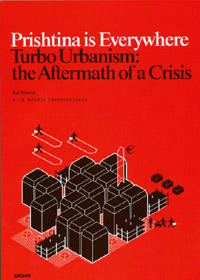27 aprile 2009

Pubblicazione che descrive e analizza la situazione di Prishtina dopo il 1999.
Nel dopoguerra del Kosovo, un fulmineo boom edilizio ha cambiato radicalmente e drammaticamente la città. Il risultato è stato uno sviluppo non strutturato che ha provocato seri problemi sia strutturali che funzionali.
After NATO-led KFOR troops ended civil war in Kosovo (1999), an instant building boom changed the capital Prishtina dramatically. Within a few years its population doubled, partly as a consequence of an influx of returning refugees. Local investors profited, creating quick returns on 'hit and run' projects. On the fringes of the city 'maverick urbanism' had a different face: family clans invested family capital in large houses, built on farmland. The result was a random spread and development of the city, causing serious functional and structural problems for the future.
Prishtina is Everywhere describes, maps and analyzes the situation in Prishtina after 1999, documents problem-solving strategies, and discusses the significance of this kind of urban development for the way urban life evolves in crisis zones. The title hints at two phenomena: firstly, urban development of this type is typical for many post-conflict situations, and secondly, most of the construction in Prishtina has been financed by remittances from family members working abroad (one-fifth of Kosovo's entire population lives abroad, specifically in Germany, Switzerland, and Austria).
This is the first of a series of investigations of urban development in post-conflict areas, initiated by Archis Interventions.
With contributions of Srdjan Jovanovic Weiss, Caroline Arnulf, Thilo Fuchs, Wilfried Hackenbroich, Irmgard Zerr, Florina Jerliu, Visar Geci, Ilir Gjinolli, Lilet Breddels, Arjen Oosterman.
Prishtina is Everywhere - Turbo Urbanism: the Aftermath of a Crisis.
di Kai Vöckler
anno di pubblicazione: 2008
Archis

